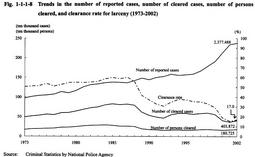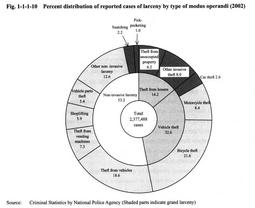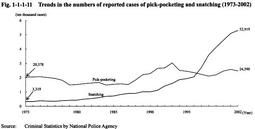| Previous Next Index Image Index Year Selection | |
|
|
3 Trends in larceny (1) Outline Fig. 1-1-1-8 shows the trends in the number of reported cases, number of cleared cases, number of persons cleared, and clearance rate for larceny over the last 30 Years. The sharp rise in the number of reported cases and the sharp fall in the clearance rate for larceny, were seen in recent years, but these trends weakened slightly in 2002.
The reported cases continued to increase significantly every year from 1998 to 2001, by 120,000, 120,000, 220,000, and 210,000. However, in 2002, they increased only by 36,977 (1.6%) from the previous year to 2,377,488. As both the cleared cases and the persons cleared increased the clearance rate recovered from 15.7% in 2001 to 17.0% in 2002. Larceny includes serious type of offenses, such as theft from houses pick-pocketing, snatching, and car theft which are called grand larceny and good index of crime trends. The number of their reported cases in 2002 was 478,476, accounting for 20.1% of the total number of reported cases of larceny. This rate has been within the 18-20% range without particular fluctuation since 1989. The clearance rate for grand larceny remained at 28.0% higher than that for all larcenies, recovering by 0.9 point from 27.1% in 2001 (Source: Data by Criminal Investigation Bureau, National Police Agency). Fig. 1-1-1-8 Trends in the number of reported cases, number of cleared cases, number of persons cleared, and clearance rate for larceny (1973-2002) (2) Trends of larceny by type and modus operandi Fig. 1-1-1-9 shows the trends in the number of reported cases of larceny by type of larceny, i.e. thefts from houses, non-invasive thefts, and vehicle thefts, over the last 30 years. Fig. 1-1-1-10 shows the percent distribution of reported cases of larceny in 2002, by type of modus operandi.
Fig. 1-1-1-9 Trends in the number of reported cases of larceny by type (1973-2002) Fig. 1-1-1-10 Percent distribution of reported cases of larceny by type of modus operandi (2002) The reported cases of theft from houses took an upward turn in 1998 after the decline for a long time from the Showa era to the beginning of the Heisei era, and in 2002, it increased by 34,596 (11.4%) from the previous year to 338,294, which was the largest number over the last 30 years. Recently, theft from houses with the use of lock-picking tools has become a problem. The number of reported cases of this kind of theft was 29,211 in 2000, 19,568 in 2001, and 19,121 in 2002 (nationwide statistics was available since 2001; Source: Data by Criminal Investigation Bureau, National Police Agency).The reported cases of non-invasive thefts has also been on the rise reaching a record high of 1,263,759 in 2002. Fig. 1-1-1-11 shows the trends over the last 30 years in the numbers of reported cases of pick-pocketing and snatching, which are included in the category of grand larceny. Fig. 1-1-1-11 Trends in the numbers of reported cases of pick-pocketing and snatching (1973-2002) The reported cases of pick-pocketing fluctuated in the 20,000-30,000 range since 1989 and there was no significant difference in between 1973 and 2002. On the other hand, the reported cases of snatching increased gradually throughout the Showa era and increased sharply from the beginning of the Heisei era, and they have been more than the cases of pick-pocketing since 1997. The number of reported cases of snatching in 2002 was 52,919, about 16 times larger than that in 1973 and about 5 times larger than that in 1989. Compared with pick-pocketing, which requires specific skills, snatching is an easier and more violent modus operandi. The sharp rise of snatching goes along with the recent increase in robbery, in particular, street robbery.While the number of reported cases increased for thefts from houses and for non-invasive thefts, it took a downward turn for vehicle thefts in 2002, decreasing by 52,158 from the previous year. The number of reported cases decreased for all types of vehicle thefts, i.e. car theft, motorcycle theft, and bicycle theft; a significant decrease was seen in motorcycle theft in particular. There are other types of larceny committed by special modus operandi such as the malicious act of taking automated teller machines (ATM) with the use of construction equipment in order to steal money stored inside the machines. According to the Criminal Investigation Bureau of the National Police Agency, this modus operandi was seen in 9 cases in 2001 and 57 cases in 2002. |



